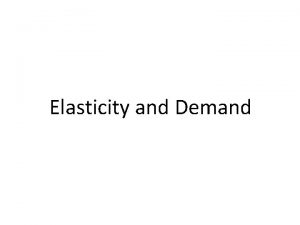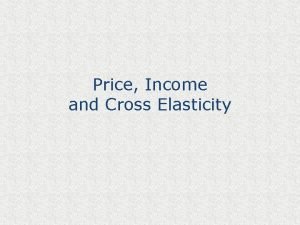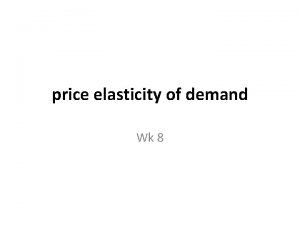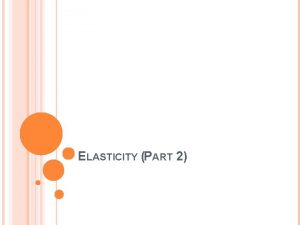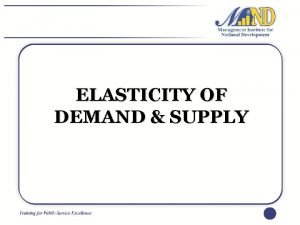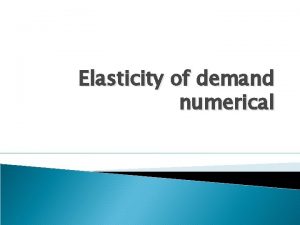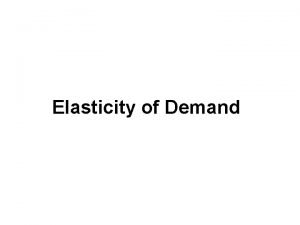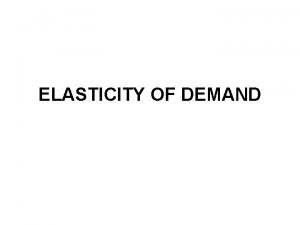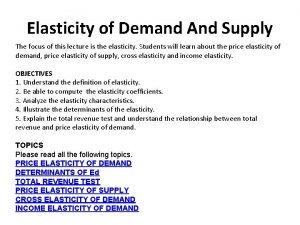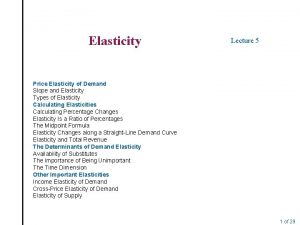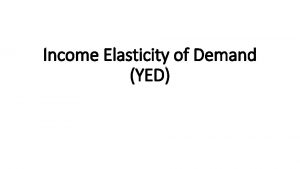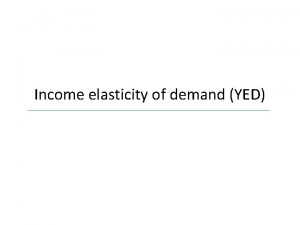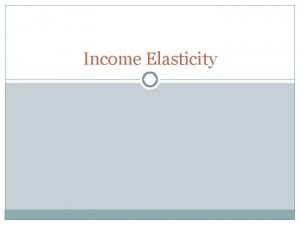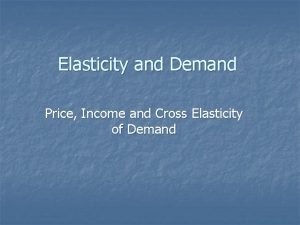Income Elasticity of Demand YED YED Learning Outcomes















- Slides: 15

Income Elasticity of Demand (YED)

YED Learning Outcomes: Outline the concept of income elasticity of demand Calculate YED Normal goods vs. Inferior goods Distinguish between income inelastic and income elastic goods Examine the implications for producers and economy

Income Elasticity of Demand (YED) YED measures the responsiveness of consumer’s demand for a particular good to a change in income. Is a measure of how much the demand for product changes when there is a change in the consumer’s income.

Income Elasticity of Demand (YED) % D Qty Demanded of the product % D in Income of the consumer

Example of YED A person has an increase in annual income from $60, 000 per year to $66, 000. She then increases her annual spending on holidays from $2, 500 to $3, 000. Calculate YED = +20% / +10% = +2

Range of values of YED The sign of YED tells us whether the product we are looking at is a normal good or an inferior good. Normal good = as income rises, the demand for the product will also rise Inferior good = demand for the product will fall as income rises and the consumer starts to buy higher priced substitutes in place of the inferior good

Interpreting the YED Coefficient Normal goods = YED is positive Inferior goods = YED is negative

Interpreting the YED Coefficient If YED value is between zero and one, the demand is income inelastic If YED value is greater than one, the demand is income elastic Necessity goods are products with low income elasticity. The demand for them will change very little if income rises. Superior goods are products that have high income elasticity. The demand for them changes significantly if income rises. If YED is one, the demand is income unit elastic

EXAMPLES: YED = - 0. 6: Good is an inferior good but inelastic – a rise in income of 3% would lead to demand falling by 1. 8% YED = + 0. 4: Good is a normal good but inelastic – a rise in incomes of 3% would lead to demand rising by 1. 2% YED = + 1. 6: Good is a normal good and elastic – a rise in incomes of 3% would lead to demand rising by 4. 8% YED = - 2. 1: Good is an inferior good and elastic – a rise in incomes of 3% would lead to a fall in demand of 6. 3%

Applications of YED allows businesses and governments to analyze the effects of changing incomes among consumers and taxpayers on the level of demand for particular goods in an economy. It enables firms to produce at a more efficient level of output. If a firm produces a good considered inferior, then a recession could be good for business & it will increase its output in order to meet the rising demand. Producers of normal goods, on the other hand, may scale back production as incomes decline.

Applications of YED Governments must recognize the effects of varying income elasticities of demand for different goods produced by their nation’s economy. A government’s decision to raise or lower income tax on households will directly affect disposable income and therefore demand for goods and services in a nation. A tax increase will reduce demand for normal goods and increase demand for inferior goods. A government must consider these effects in order to make informed decisions regarding tax policy.

YED Exercise

Exercise A consumer had an increase in income, following a salary rise, from $80, 000 per year to $100 000 per year. In the following year, her expenditure on holidays increased from $8, 000 to $10 000, her expenditure on gym membership remained the same, and her expenditure on locally produced clothes fell from $2, 000 to $1, 500. 1. Calculate her income elasticity of demand for holidays. 2. Explain what the value of her income elasticity of demand for holidays means.

Exercise A consumer had an increase in income, following a salary rise, from $80, 000 per year to $100 000 per year. In the following year, her expenditure on holidays increased from $8, 000 to $10 000, her expenditure on gym membership remained the same, and her expenditure on locally produced clothes fell from $2, 000 to $1, 500. 3. Calculate her income elasticity of demand for gym membership. 4. Explain what the value of her income elasticity of demand for gym membership means.

Exercise A consumer had an increase in income, following a salary rise, from $80, 000 per year to $100 000 per year. In the following year, her expenditure on holidays increased from $8, 000 to $10 000, her expenditure on gym membership remained the same, and her expenditure on locally produced clothes fell from $2, 000 to $1, 500. 5. Calculate her income elasticity of demand for locally produced clothes. 6. Explain what the value of her income elasticity of demand for locally produced clothes means.
 Income elasticity of demand yed
Income elasticity of demand yed Formula for income elasticity of demand
Formula for income elasticity of demand How to calculate income elasticity
How to calculate income elasticity Price
Price Cross price elasticity formula
Cross price elasticity formula Price elasticity of supply
Price elasticity of supply Promotional elasticity of demand
Promotional elasticity of demand Promotional elasticity of demand
Promotional elasticity of demand What are the 5 determinants of price elasticity of demand
What are the 5 determinants of price elasticity of demand Objectives of elasticity of demand
Objectives of elasticity of demand Negative elasticity
Negative elasticity Arc elasticity of demand example
Arc elasticity of demand example Degree of elasticity of demand
Degree of elasticity of demand Define elasticity of demand
Define elasticity of demand Perfectly elastic demand
Perfectly elastic demand Price elasticity of demand formula examples
Price elasticity of demand formula examples


